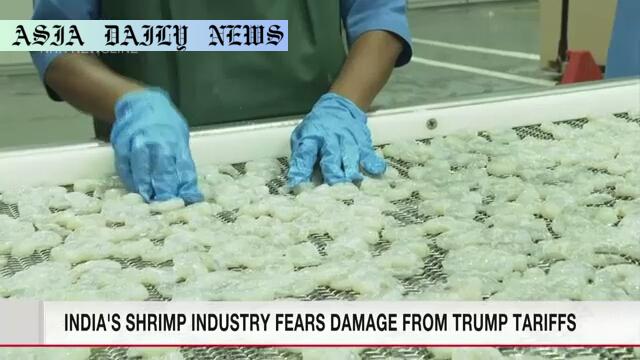Shrimp Tariffs – With the US imposing a 27% tariff, India’s shrimp industry, worth $4.9 billion, faces a bleak future.
- Key Point 1: US imposes 27% shrimp tariff, impacting India’s $4.9B industry.
- Key Point 2: Farmers face reduced prices due to impending tariff sanctions.
- Key Point 3: Over 2 million workers risk livelihoods as costs grow.
- Key Point 4: Farmers and organizations urge India-US negotiations.

The Immediate Impact of Shrimp Tariffs
India’s shrimp industry, a cornerstone of the country’s seafood exports, faces grave consequences with the United States imposing steep tariffs. The 27% tariff, though temporarily paused for 90 days, serves as a harbinger of economic distress for an industry that hinges largely on US exports. Frozen shrimp alone contributed a staggering $4.9 billion in revenue during fiscal year 2023, with the United States being its largest purchaser. Losses in this sector could send shockwaves, not just across India’s economy but also through the 2 million people whose livelihoods depend on shrimp farming and exports.The steep tariffs are already disrupting market dynamics even before their enforcement. Farmers in the southern state of Andhra Pradesh, the heart of India’s shrimp farming, report significant price drops for their produce. They are being compelled to sell at rates about 20% lower than market norms as buyers anticipate reduced demand in the US. Unfortunately, this undue burden comes at a time when the shrimp industry is already grappling with rising costs associated with feed, labor, and fuel.
Costs on Top of Costs
The triple pressures of reduced export prices, increased operational costs, and impending tariffs have created an environment of economic uncertainty. Shrimp farmers are dealing with slim profit margins further eroded by the rising costs of feed—ironically imported from the United States—alongside escalating fuel and labor prices. This cost-push inflation leaves farmers with very little discretionary earnings to absorb the impact of new tariffs. Farmers describe the situation as an existential crisis for shrimp farming in India.Calls for redress have come from multiple stakeholders, including government officials, aquaculture experts, and farming organizations. They request bilateral negotiations between India and the United States to revise the tariff structure. Without immediate intervention, the ripple effect will not only destabilize India’s shrimp industry but also impact other ancillary industries that depend on shrimp farming. This includes processing, logistics, feed supply, and export services, which collectively employ thousands.
Long-Term Ramifications
Should the United States proceed with a prolonged enforcement of the tariffs, the long-term implications will extend beyond India’s borders. The US shrimp markets may also experience price inflation due to limited supply and production disruptions. American consumers and distributors will likely bear the brunt of these tariffs in the form of higher seafood prices, leading to decreased consumption and low demand from export markets like India. On the other hand, India’s economy may lose one of its key export revenue streams, causing further imbalances in its foreign currency reserves.Experts warn that such sweeping measures require prudence, as they can severely destabilize bilateral trade relationships. Madhu Mohan Talluri, a prominent aquaculture expert, rightly points out that the shrimp export business could become economically unviable, potentially shuttering thousands of farms and putting families out of business. Farmers are pleading not for complete tariff waivers but for a rationalized approach that ensures market stability.
Moving Forward
Solutions to the looming crisis must balance the interests of both Indian farmers and US trade regulations. Lobbying by the Indian government, backed by aquaculture organizations, for more amicable tariff terms could alleviate concerns without jeopardizing bilateral relations. Diversification of export markets is another alternative India could explore to reduce over-reliance on American demand. Penetrating European and Southeast Asian markets could cushion the blow from the loss of US sales. India might also choose to offset costs by subsidizing feed imports or simplifying domestic supply chains for shrimp farming inputs.The Indian shrimp industry, given its strategic importance to the economy, cannot afford to falter. Targeted government intervention, coupled with diplomatic efforts, will be key to weathering the storm of the US tariffs and keeping the livelihoods of millions intact.



Commentary
Impact on Farmers’ Livelihoods
The news of US-imposed shrimp tariffs paints a grim picture for India’s aquaculture sector. The livelihoods of over 2 million individuals, including farmers, laborers, and ancillary workers, are at significant risk. The ripple effect on the agro economy is deeply concerning, especially when farmers already battle various operational challenges such as rising costs in feed, labor, and fuel. Shrimp farming employs a diverse ecosystem of workers, and every link in this chain faces potential disruption due to the proposed tariffs. The farmer from Andhra Pradesh who voiced his concerns represents a much larger, struggling cohort facing unforeseen hardships.The Global Trade Dilemma
While Trump’s tariff policies intend to strengthen domestic trade, they inadvertently place enormous pressures on global allies. India, a longstanding trade partner of the United States, finds itself in a precarious position, balancing domestic economic needs with diplomacy. Such policies highlight the complexities of international trade, where decisions made in one country reverberate globally. The 27% tariff disrupts not just Indian farmers but could also lead to reduced shrimp supplies in the US and potential price increases for consumers.Finding Middle Ground
There is hope that the pause on tariffs can be leveraged as a window for constructive negotiations. With the Indian government and aquaculture representatives pushing for revised terms, there is potential for a compromise that mitigates the damage. Diversification of export markets or strategic subsidies for shrimp production may also help India navigate through these uncertain times. Ultimately, farmers deserve a fair and reasonable trade framework that supports growth while balancing international trade policies. Crafting such solutions will undoubtedly require diplomacy, foresight, and an equitable approach for all involved.